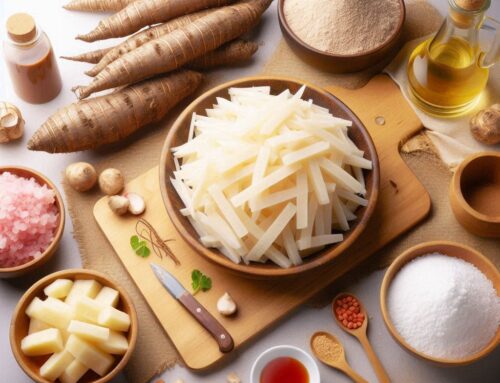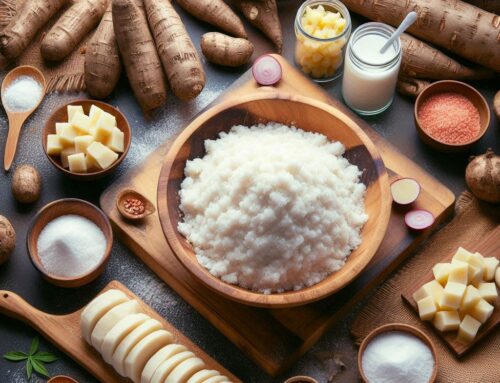
Introduction: Understanding Cassava and Its Potential as a Chalk Substitute
Cassava, a root vegetable native to South America, is gaining attention as a promising natural alternative in various applications due to its versatility and abundance. One intriguing use of the cassava plant is its potential as a chalk substitute. Traditionally known for its role in food production, cassava’s properties are now being explored beyond the kitchen.
The cassava plant produces a starchy tuber that can be processed into different forms. When considering eco-friendly options for everyday products, cassava emerges as an attractive candidate. The idea of using cassava as an eco-friendly chalk substitute stems from its biodegradable nature and low environmental impact compared to conventional materials.
By harnessing the starch from cassava roots, manufacturers can create a sustainable form of chalk that not only reduces reliance on non-renewable resources but also minimizes waste. This innovative approach aligns with growing environmental consciousness and represents a step forward in developing more sustainable educational tools.
As research continues into the diverse applications of this versatile plant, the potential for cassava to serve as an effective and environmentally friendly chalk substitute becomes increasingly clear. By exploring such alternatives, we move closer to achieving sustainability goals while embracing natural solutions that benefit both people and the planet.
The Environmental Impact of Traditional Chalk Production vs. Cassava-Based Alternatives
The environmental impact of traditional chalk production has become a growing concern, prompting the exploration of sustainable alternatives such as cassava-based chalk. Traditional chalk is primarily made from calcium carbonate, which involves mining and processing that can lead to significant environmental degradation. The extraction process often results in habitat destruction and contributes to air and water pollution.
In contrast, cassava-based alternatives offer notable environmental benefits by utilizing sustainable materials. Cassava, a readily available and renewable resource, requires less energy-intensive processing compared to traditional methods. This not only reduces carbon emissions but also minimizes waste generation during production.
Eco-friendly production practices associated with cassava-based chalk further enhance its appeal. By leveraging agricultural by-products and reducing reliance on non-renewable resources, this alternative supports a more sustainable approach to manufacturing educational materials. As awareness grows regarding the ecological footprint of traditional products, cassava-based chalk emerges as a promising solution that aligns with global sustainability goals while maintaining functionality in classrooms worldwide.
Health Benefits of Using Cassava over Conventional Chalk in Educational Settings
In recent years, educational settings have increasingly recognized the importance of using non-toxic alternatives to traditional materials, and one such innovation is the use of cassava-based chalk. The health benefits of cassava chalk are significant, particularly when compared to conventional chalk, which often contains harmful substances that can affect both educators and students.
Cassava chalk is derived from the cassava plant, a staple in many tropical regions. This natural origin makes it a safer option for classroom environments. Unlike traditional chalk, which can release dust particles that may trigger respiratory issues or allergies, cassava chalk is virtually dust-free. This characteristic helps maintain better air quality in classrooms and reduces the risk of respiratory discomfort for both teachers and students.
Furthermore, cassava-based products are generally biodegradable and environmentally friendly. This aligns with growing efforts to create sustainable educational practices by reducing reliance on synthetic materials that contribute to pollution.
Incorporating safe classroom materials like cassava chalk not only protects health but also sets a positive example for students about the importance of choosing eco-friendly options. As awareness grows about these benefits, more educational institutions are likely to adopt non-toxic alternatives like cassava chalk as part of their commitment to fostering healthier learning environments.
Cassava’s Role in Boosting Local Economies and Supporting Sustainable Agriculture
Cassava plays a pivotal role in enhancing local economies and promoting sustainable agriculture across many developing regions. As a versatile and resilient crop, cassava thrives in diverse climates and poor soil conditions, making it an ideal choice for farmers looking to maximize yield with minimal resources. The economic impact of cassava production is significant, as it serves as both a staple food and a source of income for millions of smallholder farmers worldwide.
By cultivating cassava, local farming communities can achieve greater food security while reducing dependency on imported crops. This not only strengthens the local economy but also encourages self-sufficiency. Furthermore, cassava’s adaptability allows it to be integrated into sustainable agricultural practices. It can be grown alongside other crops in intercropping systems that enhance soil health and biodiversity.
The support for local farming through cassava cultivation extends beyond individual households; it also stimulates related industries such as processing and transportation. By investing in these sectors, communities can create jobs and develop infrastructure that further bolsters economic growth. In this way, cassava is more than just a crop—it’s a catalyst for sustainable development and prosperity within local economies.
Innovative Uses of Cassava in Various Industries Beyond Education
Cassava, a versatile root crop, is gaining recognition for its innovative applications across various industries beyond its traditional educational uses. One of the most significant developments is the industrial utilization of cassava starch. Known for its binding and thickening properties, cassava starch is increasingly being used in food production as a gluten-free alternative to wheat flour. Its applications extend to the textile industry, where it serves as an eco-friendly sizing agent that enhances fabric strength during weaving.
Moreover, cassava’s potential in creating biodegradable products is revolutionizing sustainable packaging solutions. The environmental impact of plastic waste has driven research into biodegradable alternatives, with cassava-based materials emerging as a promising solution. These materials can be molded into films and containers that decompose naturally without leaving harmful residues.
Beyond packaging, the pharmaceutical industry also benefits from cassava’s properties. Cassava-derived excipients are used in drug formulations due to their non-toxic nature and ability to improve drug stability and delivery.
In summary, the myriad industrial uses for cassava starch and its derivatives highlight this crop’s potential to drive innovation while promoting sustainability across multiple sectors. As research continues to explore new frontiers for cassava applications, this humble root holds promise for contributing significantly to global industrial advancements.
Challenges and Considerations in Switching from Traditional to Cassava-based Chalks
Switching from traditional to cassava-based chalks presents a range of challenges and considerations that need careful evaluation. One primary concern is the implementation challenges associated with cassava products. Manufacturing processes for cassava-based chalks may require significant adjustments, including new machinery or alterations to existing production lines. These changes can lead to initial disruptions and require investment in staff training to ensure quality standards are maintained.
Cost analysis is another critical factor when considering this switch. While cassava is a renewable resource that might offer long-term economic benefits, the initial costs can be higher due to the need for specialized production techniques and sourcing of raw materials. A comprehensive cost-benefit analysis comparing cassava versus traditional chalks should include not only the direct expenses but also potential savings from sustainability incentives or reduced environmental impact.
Consumer acceptance issues also play a pivotal role in this transition. Users accustomed to traditional chalks may have reservations about performance differences, such as texture, durability, or color vibrancy when using cassava-based alternatives. Effective communication strategies highlighting the benefits of cassava products—such as their eco-friendliness and non-toxic nature—can help mitigate these concerns and foster consumer trust.
Overall, while transitioning to cassava-based chalks offers promising environmental advantages, it necessitates thorough planning and strategic approaches to overcome these multifaceted challenges successfully.
Conclusion: Embracing Cassava as a Natural Alternative for a Greener Future
As we look toward a more sustainable future, embracing cassava as a natural alternative presents exciting opportunities for both environmental and economic benefits. Cassava, a versatile and resilient crop, offers numerous advantages that make it an ideal candidate for promoting greener practices across various industries.
Firstly, cassava is known for its ability to thrive in poor soil conditions with minimal water requirements. This makes it an excellent crop choice in regions facing challenges related to climate change and water scarcity. By cultivating cassava, farmers can contribute to sustainable agricultural practices while maintaining productivity on less fertile lands.
Moreover, the applications of cassava extend beyond traditional food uses. Its starch is increasingly being utilized in the production of biodegradable plastics and biofuels—industries that are crucial in reducing our reliance on fossil fuels and minimizing plastic waste. As these technologies continue to develop, cassava could play a pivotal role in driving forward environmentally friendly innovations.
In addition to its industrial applications, cassava also holds promise as a nutritious food source that can help address food security issues worldwide. Rich in carbohydrates and essential nutrients, it serves as a staple food for millions globally. By supporting local economies through sustainable farming practices and value-added processing techniques, we can enhance food security while promoting economic development.
In conclusion, embracing cassava as a natural alternative not only supports ecological sustainability but also fosters economic growth and resilience against climate challenges. As industries continue to explore innovative uses for this remarkable crop, we have the opportunity to pave the way toward a greener future—one where environmental stewardship goes hand-in-hand with human advancement.






